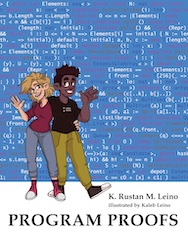
Program Proofs
Book accompaniment
© 2024. All rights reserved.
Here is a list of typos, errors, and other clarifications that were discovered after publication.
Have something else to report? Please email errata.
Thanks for your careful reading!
40-n, hours” -> “proper prefix of 40-n, h”case Yellow” -> “case YellowLeaf”Snoc in terms of Append” is referring to Exercise 6.2.Suc distributes over the first argument to Add” -> “… second argument to Add”SumpUp should read SumUp.There have also been some changes in the Dafny language and tools since the book’s publication:
Section 13.3, method Min.
The first attempt at specifying and implementing Min (Section
13.3.0) does not always assign to out-parameter m. Under Dafny’s
previous relaxed definite-assignment rules, this program is
allowed and lives up to its specifications. This is the behavior
you will get from the legacy command-line interface (CLI), and you
can also get it from the new CLI and from Dafny IDE in VS Code if
you use the --relax-definite-assignment option. However,
starting in Dafny 4.0, the default in the new CLI and IDE is
Dafny’s strict definite-assignment mode. It will not accept a
method with unassigned out-parameters, even if (as in the case of
Min) the compiler can provide a type-safe initialization
automatically.
This means that the specification omission discussed in Section
13.3.1 will actually be detected by Dafny in the Section 13.3.0
program. Once you add the ensures exists ... postcondition from
Section 13.3.1, you’ll be able to complete the full program.
Two more notes about the change in definite-assignment rules: One
is that what Dafny does in the relaxed mode is still correct,
because the compiler will auto-initialize the value of the
out-parameter. The other is that, if you really want the
specification from Section 13.3.0, then the implementation given
there can be made correct in the strict definite-assignment mode
if you add the assignment m := *; at the beginning of the method
body.
Section 13.7, method DetermineElection.
Since the time the book went into production, some necessary
changes were made to the verifier. It now takes more effort to
convince the verifier that DetermineElection returns NoWinner
under the right circumstances. For more information and two
solutions, see the code that accompanies the book on this web
site.